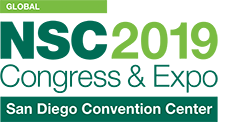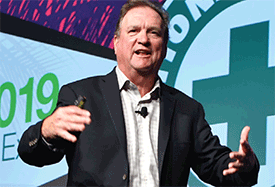A look back at the 2019 NSC Congress & Expo

Entrepreneur, philanthropist inspires Opening Session attendees to help others
For Mick Ebeling, it started with one solution, which led to another ... then another ... and another.
At an art gallery show to benefit Tony Quan, a Los Angeles street artist with Lou Gehrig's disease, Ebeling, a veteran of the film production industry, began to look for answers to seemingly impossible challenges to help benefit humanity.
Speaking to several thousand safety professionals Sept. 9 during the Opening Session of the National Safety Council 2019 Congress & Expo, Ebeling shared how his company, Not Impossible Labs, was born.

Speaking to several thousand safety professionals Sept. 9 during the Opening Session of the National Safety Council 2019 Congress & Expo, Ebeling shared how his company, Not Impossible Labs, was born.
"When you see something that's absurd that has to change and it speaks to you, first you commit and then you figure it out," Ebeling said. "That's what you all do all the time anyway. You see a problem that has to be solved. Do you know how to do it when you say you're going to do it? No."
Determined to help Quan, Ebeling invited a diverse group of "makers, hackers and mad scientists" to move into his home, where they came up with the Eyewriter. The device tracked Quan's eye movement, allowing him to draw for the first time in seven years.
When Ebeling learned of a missionary doctor in Sudan who was treating thousands of amputees during an ongoing war in the region, Ebeling worked with his team to produce low-cost, 3D-printed prosthetic hands and arms to help change the lives of those affected.
Among them was 12-year-old Daniel, who badly feared being a burden on his family. A prosthetic arm allowed Daniel to feed himself for the first time in two years and gave him a new lease on life.
"How will you use your intelligence and skills?" Ebeling asked the audience. "How can you use that to help people? Who is your 'one'? Who is your Daniel?"
NSC President and CEO Lorraine M. Martin began the Opening Session talking about how safety leaders who see with their own eyes the challenges their workers face can have a bigger impact.
"To me, leadership means showing up and never leaving your people behind," Martin said. "I discovered that improving safety required showing up as a leader to see what we ask of our people and to see what's in their way."
For Martin, who worked in the aerospace and defense industry at Lockheed Martin for more than three decades, that included crawling on her back inside the wing/fuel tank of a C-5 cargo plane to discover issues with fasteners inside the tanks.
"Being there and seeing it for myself made me realize we could engineer better tools for our mechanics, and we did just that," Martin said. "Serving as a leader means you show up for those around you. That is what safety leaders do."
Leadership Keynote speaker: The future is approaching rapidly – prepare now

Safety professionals need to prepare now for a future that is coming faster than many anticipate, futurist and trends and innovation expert Jim Carroll said Sept. 11 during the Leadership Keynote at the National Safety Council 2019 Congress & Expo.
One of his objectives, Carroll said, was to "scare and terrify" the audience about new trends reshaping the world and their ensuing safety risks. He also, however, encouraged safety pros to view the future as an opportunity, not a source of fear.
Carroll said the future can take us in directions that we can't even imagine today, such as welders or truck drivers performing their tasks from thousands of miles away through virtual reality. He also predicted that 65% of today's preschool-age children will work in jobs or careers that don't exist yet.
"How are you going to mitigate safety risks for jobs and careers which are not yet in existence?" Carroll asked.
He urged safety pros to ensure they are part of any discussion about the future and encouraged them to adopt an "innovation mindset": think big, start with small changes and prepare to move fast.
"You need to be involved in the future," he said. "You need to understand these trends. You need to assess the reality of the risks that can come.
Post a comment to this article
Safety+Health welcomes comments that promote respectful dialogue. Please stay on topic. Comments that contain personal attacks, profanity or abusive language – or those aggressively promoting products or services – will be removed. We reserve the right to determine which comments violate our comment policy. (Anonymous comments are welcome; merely skip the “name” field in the comment box. An email address is required but will not be included with your comment.)

